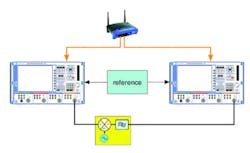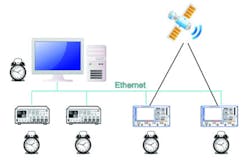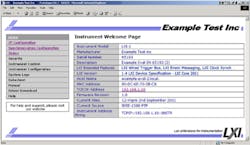Using LXI in Satellite System Testing
Satellites are involved in a wide range of applications including scientific research, weather prediction, navigation, and military/aerospace. The greatest numbers of satellites that orbit the earth today are used for communications, enabling people across the globe to communicate with one another. In fact, more than half of the satellites in space are used for telecommunications. Beyond telecommunications, satellite communications are intrinsically tied to almost every aspect of our daily lives whether we realize it or not.
Perhaps the most tangible form of satellite communications is the transmission of our favorite television shows from around the world. Furthermore, airport command and control centers rely on satellite communications to ensure our loved ones return safely from their travels. And in times of natural disaster, such as the 2001 World Trade Center attack, the 2005 tsunami in the Indian Ocean, or Hurricane Katrina in 2006, satellites often are the only means of communications available.
A new two-tone method that makes use of LXI technology has been developed that allows users to measure relative group delay with high precision on converters and mixers. The measurement can be made without local oscillator (LO) access as is typically the case in satellite communications systems.
LXI Technology
LXI is the standard for Ethernet control of instrumentation in the test and measurement industry. LXI’s compact and flexible package, high-speed I/O, and reliable measurements meet the needs of R&D, design, validation, and manufacturing engineers delivering electronics for the aerospace/defense, automotive, industrial, medical, and consumer electronics markets.
LXI is particularly favored by the aerospace/defense industry where strict adherence to standards and compliance is a necessity. All LXI products are certified compliant with the LXI standard, ensuring test engineers that a combination of LXI products will integrate well together and that there is a consistent user experience between products.
By standardizing and extending the LAN to instrumentation support, LXI simplifies the use of Ethernet for test systems, providing a low-cost, cross-platform computer interface that can be controlled at any distance.
A Need for Higher Reliability
In satellite communications, a baseband signal of large bandwidth is up-converted to a high-frequency signal at the transmitter end, and the high-frequency signal is down-converted to the baseband at the receiver end. The performance of such a system is highly dependent upon transmission quality. The system should achieve constant magnitude and linear phase response, resulting in constant group delay vs. frequency of the transmission coefficient within the used frequency band.
In this case, the phase of the transmission coefficient cannot be measured directly because the input and the output signals have different frequencies. Moreover, the phase of the output signal is influenced not only by the DUT, but also by the frequency and phase drift of its LO. Additionally, in the case where input and output of the transmission system are located far apart, the group delay and phase are very difficult to measure.
The two-tone method1 overcomes these problems. This method stimulates the DUT with a two-tone signal, whereby the network analyzer measures the phase difference between the two carriers, both at the input and the output of the DUT. From the resulting phase differences and the carrier frequency offset, the analyzer calculates the group delay. As a result, the influence of one or more inaccessible LOs of the transmission system is eliminated.
It also is possible to measure group delay on a transmission system by means of two LXI-based network analyzers, one at the transmitting end and the other at the receiving end, that communicate with one another using LAN messages. The LXI network analyzers are connected to one another via a LAN router with an integrated DHCP server that assigns the IP addresses to the devices. Alternatively, the devices can use fixed IP addresses.
Figure 1 shows the test setup where one LXI network analyzer acts as a master, the other one as a slave. The master controls the slave via a LAN/WAN connection and processes and displays the results.
Synchronization with IEEE 1588
The LXI clock synchronization extended function inherits IEEE 1588-2008 Precision Time Protocol used to synchronize real-time clocks with submicrosecond accuracy in devices of a networked distributed system. This allows common timer events to be tied to absolute times for very precise triggering and synchronization and enables the correlation between instruments to aid monitoring and debugging. In the two-tone measurement example in Figure 2, LXI clock synchronization enables the LXI network analyzers to be synchronized with one another as well as with their PC controller.
Remote Configuration and Monitoring
All LXI instruments are required to provide a browser-based web interface to be compliant with the LXI standard (Figure 3). Each device incorporates a standard set of web pages that offers useful information about the instrument and allows you to configure the LAN interface. Unlike traditional GPIB or other modular test systems that require the user to be nearby to monitor and control the system, LXI enables complete control over the test system from anywhere in the world, significantly lowering operational and maintenance costs. You can review and modify settings, examine acquired data, and operate the instrument from an intuitive graphical user interface that significantly improves user experience and simplifies the basic tasks of instrument control and interactive operation.
Distributed Test Systems
Typical communications interfaces have distance limitations between instruments and controllers. The two-tone method for measuring group delay, where the network analyzers are not physically in the same location, simply would not be possible using GPIB or other modular test systems such as PXI or VXI. Since LXI instruments are based on LAN/Ethernet which can be securely transmitted over the Internet, they can be used in distributed applications and controlled remotely. Furthermore, an LXI distributed system allows the instruments to be close to the devices to be tested, reducing cable lengths to provide less signal attenuation.
Summary
Satellite communications enable many of the services that we rely upon today. Since performance is highly dependent upon transmission quality, test engineers must find a reliable way to measure group delay where the transmitters and receivers are geographically separated by significant distances from one another as well as from their controller.
The two-tone method integrated into network analyzers featuring LXI technology allows accurate measurement of the relative group delay of the converters and mixers used in the satellite systems and ensures that they are designed to meet the current and future needs placed upon such systems. Based upon widely used standards such as Ethernet and the web, the LXI standard enables the connection of intelligent instrumentation which supports distributed processing of measurement data and provides a high-bandwidth interconnect system for supporting applications with high data demands.
Reference
1. Bednorz, T. and Wolle, J., “New Group Delay and Phase Measurement Method for Long Distance Transmission,” Microwave Journal, Aug. 10, 2011.
About the Author
Jochen Wolle is chairman of the LXI Conformance Committee and represents Rohde & Schwarz on the Board of Directors of the IVI Foundation and LXI Consortium. He is director for R&D test and measurement at Rohde & Schwarz Asia Pte Ltd and studied electrical engineering at the Technical Universities of Darmstadt and Munich.



